| Columns Retired Columns & Blogs |
9th paragraph
The DB1's internal electronics include a signal input circuit board that concrets the analog input ( concrets ?, includes ? perhaps)
Testing subwoofers is not as lonely a business as I had thought. One Stereophile reader, Darren Gum, wrote to criticize my use in reviews of extra hardware to achieve more transportable subwoofer setups; eg, the virtual spectrum analyzer in my Velodyne DD-18 subwoofer (reviewed in June 2004), and Bryston's 10B-SUB outboard electronic crossover ($2395; reviewed in May 1994 and November 2005), which I used with subwoofers that didn't have high-pass feeds for the satellite speakers. Gum worried that most audiophiles wouldn't have access to the extra gear, and that different results might have occurred had I used only my ears.
His argument made sense. Most readers set up their subwoofers by ear, unless the dealer comes by to "tune" the system. Using my ears to set a subwoofer's polarity, match its output to that of the Quad ESL-989s, and set its low-pass filter's frequency would either work as well as my extra gear or not. I decided to try it both ways: I first set up the B&W DB1 using only my ears, then set it up again using my measuring gear.
Before setting up the DB1, I measured the Quads' room response using the signal generator and spectrum analyzer built into the Velodyne DD-18 subwoofer that sits at the center of my room's front wall. Clearly, using Velodyne's electronics was not part of the B&W's setup instructions, but had proven helpful in setting up other subs.
After setting the DD-18's volume control to "0" so that its 18" drive-unit would remain silent while I took measurements of the B&W, I rested the Velodyne calibration mike on the back of my listening chair, at my seated ear height of 37" above the floor and triggered a repeated 20–200Hz sweep tone that I fed into the Auxiliary input of my Bryston BP-26 preamplifier. The Velodyne's sweep signal revealed that the Quads' output was relatively flat down to 80Hz, then fell 10dB by 35Hz (fig.1). I then measured the DB1's uncorrected in-room response, which revealed strong output from 20 to 200Hz, with prominent room modes evident at 45 and 65Hz (fig.2).
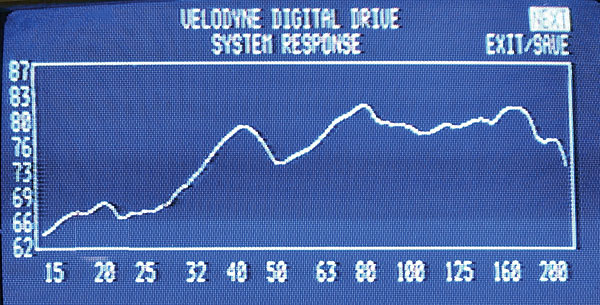
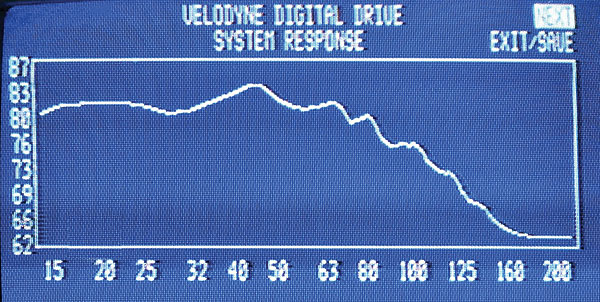
Following the online instructions, I set up B&W's Room Acoustics Compensation program by plugging the DB1's soundcard into a USB port on my Windows laptop; connecting one cable to the soundcard's minijack connectors to send its test signals to the sub, and another to receive the feed from the calibration mike; and plugging a third, long USB-to-RS232 cable from a second USB port on my laptop into the RS232 connector on the DB1's service panel.
That done, I ran B&W's SubApp Windows program. When I first clicked the on-screen Run button, the DB1 played some rapidly stepped test tones, then stopped and indicated that the volume level was too low for it to take a measurement. I checked and found a loose connection in a cable plugged into the soundcard output. I fixed it, then successfully reran the compensation routine, which involved the App taking eight different measurements, without the Quads connected (fig.3).
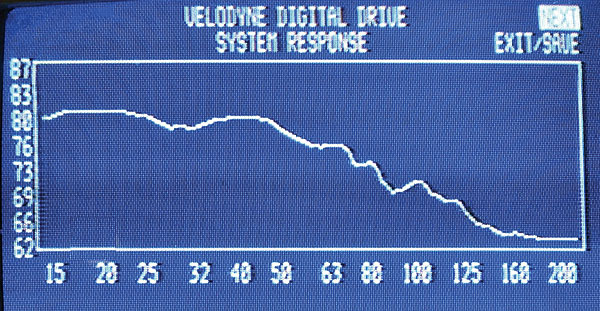
To set up by ear, I turned the Quads back on and matched the DB1's volume, phase, and polarity settings, ran the Room Acoustics Compensation, and listened for the tightest bass. I left the DB1's low-pass filter at its default setting of 80Hz, and selected a low-pass filter slope of 24dB/octave. I saved these settings as Preset 1. To my surprise, the Velodyne's spectrum analyzer showed a surprisingly flat in-room response (fig.4). The sound was spectacular, especially playing organist James Busby's recording of Herbert Howells' Master Tallis's Testament, from Pipes Rhode Island (CD, Riago 101, no longer available). I was delighted to hear extraordinarily tight, clear, sustained organ-pedal notes reproduced with good pitch definition and solidity, and with enough power to shake loose objects in my listening room.
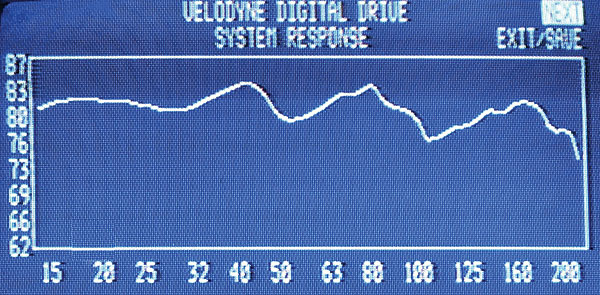
To set up by gear, I returned the DB1 to its factory default settings—no room compensation—by selecting a new Preset to clear out the previous Room Acoustics Compensation settings. I ran SubApp a second time, and used my laptop's keyboard to adjust the virtual gain sliders in SubApp to match the outputs of the DB1 and the Quads while watching the resulting room-response curve on the TV monitor. I then adjusted the DB1's low-pass filter frequency to achieve the flattest line on the sweep signal display. The display showed that a low-pass frequency of 70Hz—not the 80Hz I'd used before—and a low-pass filter slope of 24dB/octave gave the flattest line representing the room response. Finally, I found that setting the DB1's phase to 90° gave the flattest response on the TV monitor, not the default 0° setting I'd used before (fig.5). I loaded the new settings into Preset 2, then again played Master Tallis's Testament. I heard the same clean, deep bass, and this time it was even more focused and solid.—Larry Greenhill
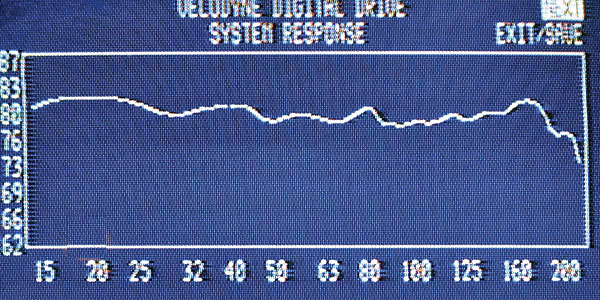

I have been "messing about" with subwoofers since 1977 when I got a 12" "acoustic suspension" subwoofer to augment the bass on my Magnepan MG-IIs. This was a passive sub whose adjustability consisted in using various resistors to adjust its level relative to the main speaker. While it added need punch for rock records, it did nothing for the quality of the sound and I never used it when listening to classical music.
In 1979 I sold the entire rig because I didn't have a room big enough to accommodate all of that stuff.
15 years later, I got a Mirage BPS-150 powered sub with the usual crossover and level controls. I never successfully mated it with the first pair of speakers I tried (Snell K-IIs), but after much trial and error got it to sound acceptable with Joseph RM-7sis. At that point someone one of the Audio Asylum boards mentioned the inexpensive Behringer parametric equalizers, which can be used with a calibration mic. I managed to get one used, even cheaper. Finally, really good bass that did not boom, although the Mirage really didn't do much below 30 Hz. Replacing the Mirage with a REL Q400E got me a little more extension with much better definition.
Here's my point: the chances of a serious audiophile making a net improvement in sound adding in a subwoofer "by ear" are, I believe, very small; and the chances of worsening the sound are not insignificant. So, the audiophile who can't afford a self-calibrating sub like the one you reviewed should, I think, either by a unit like the Bheringer or save his/her money.